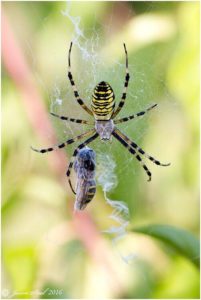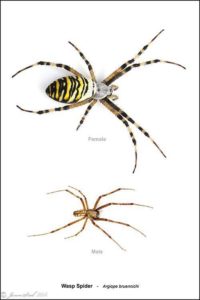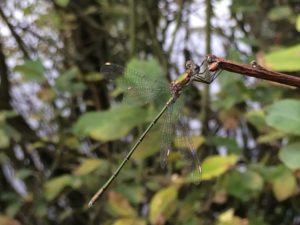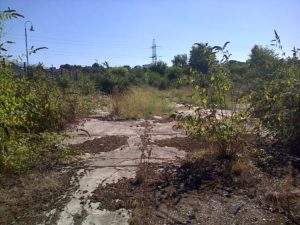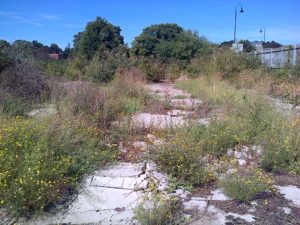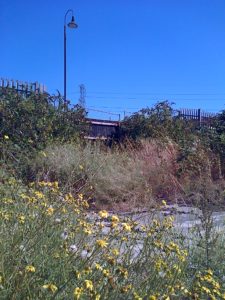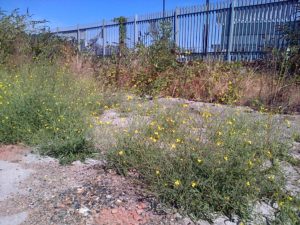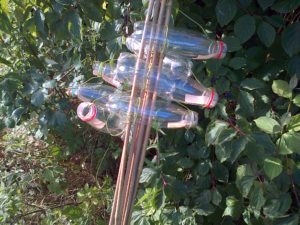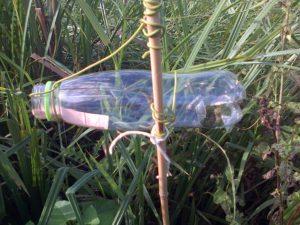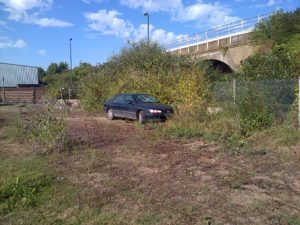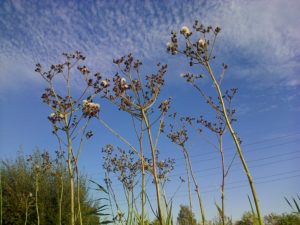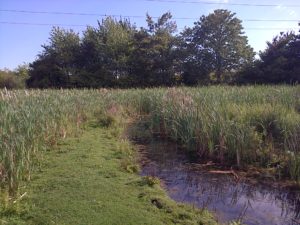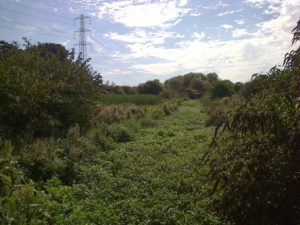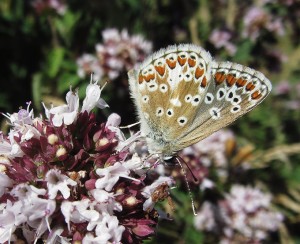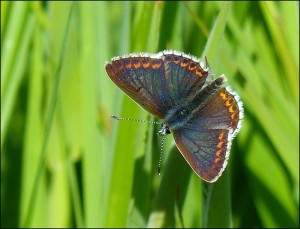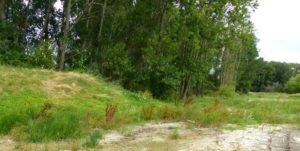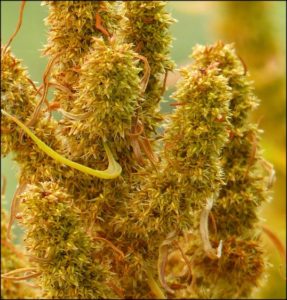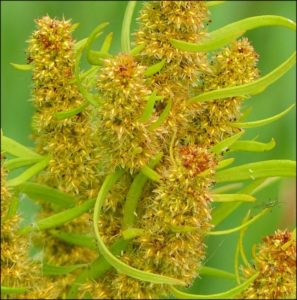On a warm sunny day at London Wildlife Trust’s Braeburn Park reserve there were fair numbers of butterflies about. Holly Blues were seen across the site. Some male (mostly) and female Common Blues were on the large grassy/scrubby bund to west of the housing estate, with a few more along part of the wide Marjoram-lined path at north foot of the valley slope. 1 Brown Argus was on the bund, with 1 and very probably 2 also in the Marjoram area, nectaring on the flowers of this plant.
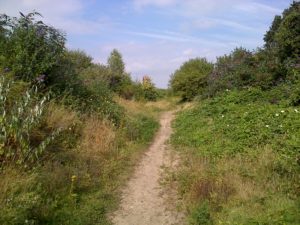
The wide grass ‘verge’ along this pathway, populated by Marjoram, provides nectar for Brown Argus and Common Blue butterflies. (Chris Rose)
1 fresh Small Heath was on the bund. A Painted Lady was in the ravine. A single Small Tortoiseshell and Speckled Wood were seen. There was a limited number of Gatekeepers and plenty of Meadow Browns. Green-veined and Small Whites were about.
There were 2, possibly 3 Jersey Tiger moths in the ravine and 1, possibly 2 in adjacent quarry, though given the way they seem to fly about randomly there might have only been 2 or 3 in total. 4 Silver Y moths were disturbed on the bund.
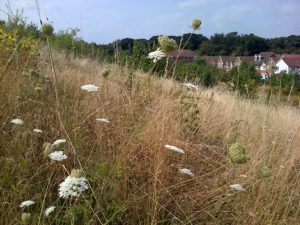
The ‘bund’ at Braeburn, screening the industrial estate from the nearby housing, is good grassland butterfly habitat. (Chris Rose)
A somewhat haphazard search for Wasp Spiders on the bund located just two of these colourful arachnids, with much of the grass looking too tall, dense or flopped over to provide ideal habitat.
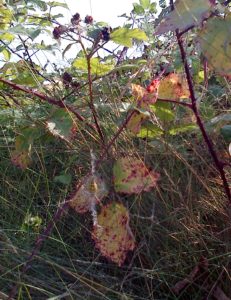
Wasp Spider at Braeburn (Chris Rose)
There were a few Migrant Hawker Dragonflies in the air, but not much bird activity.
Upright Hedge-parsley (Torilis japonica), a sort of skinnier, much later flowering cousin of Cow Parsley, was in flower in good numbers at the eastern end of the north part of the site, possibly its only location in Bexley. Bexley rarities such as Marjoram and Wild Basil are, however, getting crowded out by the proliferating non-native Goat’s-rue and Bramble, and LWT could very much do with more volunteers from the Bexley wildlife community to help tackle this and other work.
There was a single Common Centaury on a south-facing sandy bank, a plant I’ve only found at two other Bexley locations, in one of which it has probably been destroyed by an advertising hoarding.
Tree of Heaven and False Acacia along the line of the old A2, provide the threat of additional ‘exotic’ encroachment, though they seem fairly well contained by the habitat conditions at present.
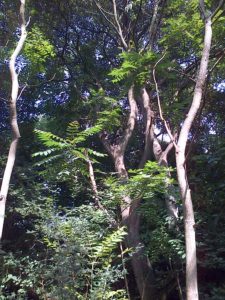
Some tall Tree of Heaven lend an exotic jungle-like air along the old A2 route. (Chris Rose)
It was disappointing to note on the path by the A2 up to Churchfield Wood that the seasonally wet ditch beside it is now occupied by a black plastic pipe, presumably to ‘control’ any water.
I hadn’t appreciated it before, but I have now noticed that at least the lower part of the wooded slope has many old coppiced Hazels, mirroring the situation across the A2 at the west end of Braeburn.
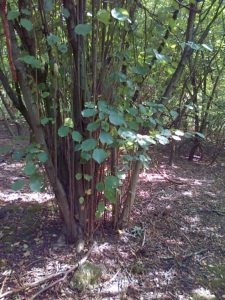
A dense array of old coppiced hazels predominate on the thereby heavily shaded west end of the wooded Cray valley slope at Braeburn. (Chris Rose)
Having refreshed my memory about these two sites it very much looks as if the habitats are not suitable for range expansion of Silver-washed Fritillary and White Admiral into these areas from Joydens Wood. The food plants look to be absent in Churchfield Wood as well.
I only skirted the northern margin of the field to the south of Churchfield Wood, but found a fair amount of the London rarity Hare’s-foot Clover, which also occurs on a small part of Braeburn.
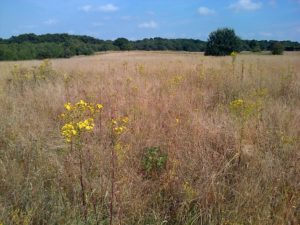
Field by the A2, south of Churchfield Wood (Chris Rose)
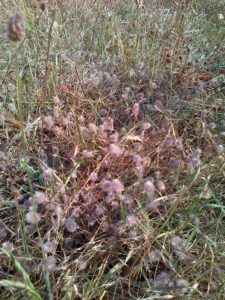
Hare’s-foot Clover near the southern margin of Churchfield Wood. (Chris Rose)
There are a few apple trees near the woodland margin, either side of the footpath to St. Mary’s church. Whether from discarded cores or the remnants of previous orchards, they seem to fruit very well.
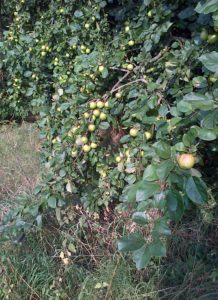
Apple tree on footpath towards St Mary’s church. (Chris Rose)
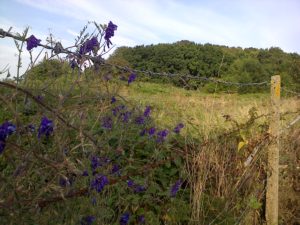
A colourful Vetch drapes the footpath fence, looking back to the edge of Churchfield wood. (Chris Rose)
A Southern Hawker Dragonfly further along the path conveniently settled on the cemetery hedge and allowed an extremely close approach. The last two coloured rings on the abdomen are complete rather than broken as in the Migrant Hawker.
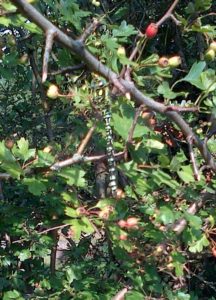
Southern Hawker Dragonfly on St. Mary’s cemetery hedge. (Chris Rose)
Harebell, now a very rare plant in London, prospers in a few Bexley Borough churchyards, including having a modest showing in St. Mary’s. I can’t help feeling that some modest changes to management regimes could significantly grow the numbers of this very attractive plant.
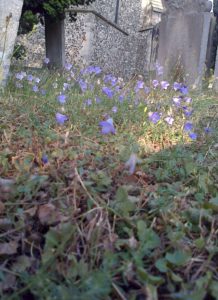
Harebell in St. Mary’s churchyard, Old Bexley (Chris Rose)
Good swathes of Tansy survive along the footpath below the south side of Bexley railway station, though they seem rather more overgrown with other species than I recall them being last time I looked.
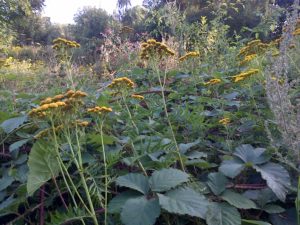
Tansy, an uncommonl plant in Bexley, flourishes on Mill Meadow by the footpath to the south side of Bexley station. It is in the daisy family and has slightly domed clusters of bright yellow flowers that lack ray florets (‘petals’) . (Chris Rose)
Chris Rose
